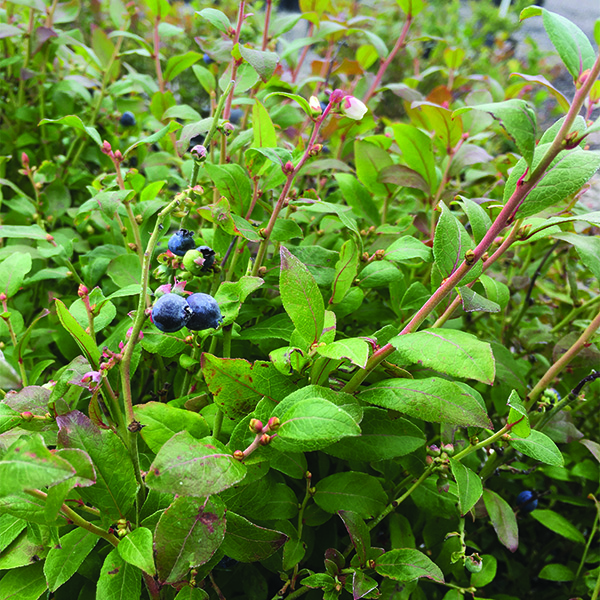
Brunswick Blueberry
Vaccinium angustifolium 'Brunswick'
94 reviews
Brunswick Blueberry
Vaccinium angustifolium 'Brunswick'
94 reviews
1 Gallon
We are sorry, product is currently out of stock due to seasonal availability. Please check the "Related plants available in your area" section below
Not just beautiful - intentionally selected by ShrubHub's 3D landscape design team to fit real-world spaces and maximize yard potential.
Why Brunswick Blueberry?
Brunswick Blueberry (Vaccinium angustifolium 'Brunswick') is favored for its high-yielding, juicy and flavorful berries. It is a hardy, deciduous shrub that grows up to 5 feet tall with glossy green leaves that turn crimson in the fall. The Brunswick variety is known for its resistance to pests and diseases, making it easy to grow even for beginner gardeners. It's a great addition to gardens, landscapes, and even container gardening.
Sunlight
Brunswick Blueberries require full sun exposure to thrive and produce an abundant harvest. They need at least 6-8 hours of direct sunlight each day to ensure optimal growth and fruit development.
Watering
Brunswick Blueberry plants typically require regular watering, especially during dry periods. They prefer well-draining soil that is evenly moist but not waterlogged. It is essential to keep the soil consistently hydrated to promote healthy growth and frui
Fertilizing
Brunswick Blueberry requires a balanced fertilizer with a 10-10-10 NPK (nitrogen, phosphorus, and potassium) ratio. It is recommended to apply the fertilizer in early spring before the new growth starts, and then again after the fruit has been harvested in
The Brunswick Blueberry is a modern cultivar of Wild Blueberry, native to eastern Canada. The lowbush blueberry shrub is low-growing with a dense habit. It blooms with stunning white flowers against glossy, dark green leaves that turn a fiery crimson in the fall. Brunswick Lowbush Blueberry also produces firm, beautiful, and delicious blueberries.
The firm powdery-blue fruit can be enjoyed fresh or baked into various recipes. The lowbush blueberries are also attractive to native bees and butterflies. As for care, Brunswick Blueberry is easy to take care of and is generally low maintenance.
They are hardy to growing zones 3 to 8 (sometimes 2, as they are exceptionally adaptable to cold winters) Brunswick Blueberries grow well in full sun to partial shade. They tolerate poor, sandy, and dry soil. Generally, they grow best in well-drained soils, with an acidic ph, as they are acid-loving plants. A well-drained acidic soil with the full sun will give your plant everything it needs.
Brunswick Lowbush does not require heavy pruning, especially in the first few years after planting. It's recommended to prune in early spring every couple of years to encourage a more abundant fruit yield.
Brunswick Lowbush has no concerning pests or disease problems. It is widely adaptable for growing as a low hedge, natural edging for garden beds, groundcover, or container specimens.
Its dense habit makes a practical and useful mass planting or groundcover. It can also be used as a beautiful low hedge or edging plant. The sure thing is, wherever you plant it in your landscape, it'll attract all attention. Order yours from Shrubhub today to start enjoying this shrub!
Plant Information:
| Botanical Name: | Vaccinium angustifolium 'Brunswick' |
| USDA Zones: | 2 - 8 |
| Water: | Medium |
| Exposure: | Full Sun |
| Soil Needs: | Well Drained |
| Mature Height: | 12 - 15 inches |
| Mature Spread: | 1 - 4 feet |








Pollination Info
Pollination Information for Brunswick Blueberry (Vaccinium angustifolium 'Brunswick')
Brunswick Blueberry is a self-fertile blueberry plant, meaning that it can produce fruit with its own pollen. However, you can increase your yield by planting multiple blueberry varieties together, which can cross-pollinate each other and lead to larger and more flavorful fruits.
It is important to note that pollination requires bees and other pollinators, which transfer pollen from the male parts of flowers to the female parts. To attract more pollinators to your blueberry plants, you can provide flowering plants nearby, such as clover, wildflowers, and flowering shrubs.
Additionally, make sure to avoid using pesticides that are toxic to bees and other beneficial insects, as this will diminish the pollination process and ultimately affect the quality and quantity of your blueberry crop.
FAQ
Brunswick Blueberry (Vaccinium angustifolium 'Brunswick') FAQ:
Q: What is a Brunswick Blueberry?
A: Brunswick Blueberry is a cultivar of the lowbush blueberry (Vaccinium angustifolium) that produces sweet and flavorful blueberries.
Q: What are the characteristics of a Brunswick Blueberry?
A: Brunswick Blueberry has a compact growth habit and can reach a height of 1-2 feet. It produces small to medium-sized blueberries that are dark blue and have a sweet and intense flavor.
Q: When does a Brunswick Blueberry produce fruit?
A: Brunswick Blueberry usually begins to produce fruit in mid to late summer, typically in July or August.
Q: How do I care for my Brunswick Blueberry?
A: Brunswick Blueberry prefers well-drained, acidic soil and full sun to part shade. It should be watered regularly, especially during periods of drought. Fertilizing once a year with an acidic fertilizer can also promote growth and productivity. Pruning should be done in late winter or early spring to remove dead or diseased branches and to encourage new growth.
Q: What pests and diseases should I watch out for with my Brunswick Blueberry?
A: Some pests that may affect Brunswick Blueberry include blueberry maggot, cherry fruitworm, and spotted wing drosophila. Diseases that can affect Brunswick Blueberry include mummy berry, powdery mildew, and stem canker. Good cultural practices, such as maintaining proper soil moisture and pH, can help prevent many of these issues. In some cases, chemical treatments may be necessary.
Q: Can I grow a Brunswick Blueberry in a container?
A: Yes, Brunswick Blueberry can be grown in a container as long as it is large enough to accommodate the plant and has good drainage. The soil should be acidic and high-quality potting soil can be used. Container-grown plants may require more frequent watering and fertilizing than plants grown in the ground.
Q: Can I eat a Brunswick Blueberry right off the bush?
A: Yes, Brunswick Blueberry can be eaten fresh off the bush and is delicious when added to smoothies, baked goods, or eaten as a snack.
Planting & Care
Planting & Care for Brunswick Blueberry
Vaccinium angustifolium 'Brunswick', commonly known as Brunswick Blueberry, is a deciduous shrub that produces delicious blueberries from mid to late season. Below are the guidelines for planting and maintaining a healthy Brunswick Blueberry plant:
Planting
1. Choose a spot with well-drained soil and full sunlight.
2. Dig a hole slightly larger than the root ball.
3. Mix in compost or organic fertilizer with the soil.
4. Place the plant in the hole and backfill with soil.
5. Water thoroughly.
6. Mulch around the base of the plant to help retain moisture.
Care
1. Water regularly, especially during dry periods.
2. Fertilize in early spring with a balanced, slow-release fertilizer.
3. Prune in late winter or early spring before new growth appears.
4. Remove any dead or diseased branches.
5. Protect the plant from birds with netting or bird scare devices.
6. Monitor for pests and diseases and address as needed.
7. Harvest blueberries when they are fully ripe and have turned blue.
Following these guidelines will help ensure a bountiful harvest of delicious and healthy blueberries.
Check Out These Verified Customer Reviews:
Customer Reviews
4.7 out of 5 based on 94 reviews
Thank you! Your review has been submitted.
Fresh and juicy fruit
Blueberries were good but a few were slightly mushy. Overall decent experience.
Quick delivery service
Item has been added to your cart.


